Refresher: Iteration 1¶
Question¶
What is the output of the following?
a = 3
a *= 4
print(a)
Choices*
- 3
- 4
- 7
- 12
Question¶
What is the output of the following?
a = 5
if(a < 6):
print('Option 1')
if(a < 3):
print('Option 2')
else:
print('Option 3')
Choices
- Option 1
- Option 2
- Option 3
- Option 1
Option 3
Question¶
What is the output of the following?
a = 1
b = 0
c = 1
if ( a and b):
print("Option 1")
elif (a and c):
print("Option 2")
else:
print("Option 3")
Choices
- Option 1
- Option 2
- Option 3
- Option 4
Question¶
What is the output of the following?
count = 0
while(count < 10):
print(10, end = ' ')
Choices
- 0 1 2 3 4 5 6 7 8 9
- Infinite Loop
- 10 10 10 10 10 10 10 10 10 10
Introduction¶
- Imagine we wish to print the numbers from
1to1000. - So we can write the code as follows:
print(1)
print(2)
..
..
..
print(1000)
- This is not an intelligent task to do. If the task is simple and we want to repeat it 5 times, we might write the same piece of code 5 times But this is not a practical approach if the repetition number is like
100or1000. - There is a principle in programming called DRY
Do you know the full form of it?
- Don't Repeat Yourself
- Even if you are writing the same code three times, you are not doing a good job at it. We can either use loops or functions.
- Before seeing loops, let us see why Python does things in a certain way.
- I have a friend Ramesh and I have to take
10toffies from him. I will pick a chocolate and start counting from1until I reach10and then stop. - Let us see in code what we are doing. Each time in a loop we will check if condition until we reach the else part.
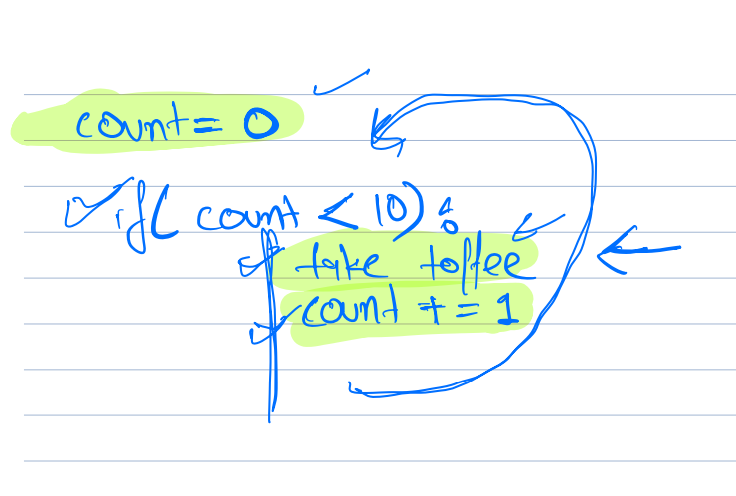
count = 0
if(count < 10):
take toffee
count += 1
else
stop
- There are four things we always do in a loop:
- Initialization
- Condition
- Action
- Updation
- We will discuss the
whileloop in this class and theforloop in the next as it is different in different programming languages. - The while loop will only run till the condition is true. As soon as the condition becomes false we exit the loop and execute the rest of the code.
Syntax¶
variable initialization
while (condition)
{
action
update variable
}
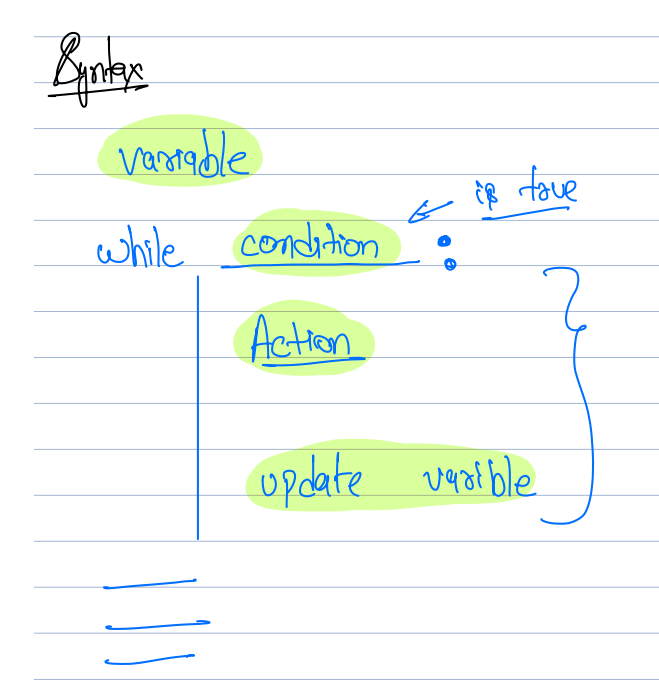
This can be read as while this condition is true perform this action and update the variable.
Let us quickly move to an example to understand better.
Print numbers from 1 to n¶
Example 1 - Print Numbers from 1 to n¶
n = input()
count = 1
while(count <= n): # can also be written as (count < n + 1)
print(count)
count += 1
print("end")
- Parenthesis are optional in while condition.
- Dry run for n = 5
If I do not write the incrementing count statement what will happen?
It will fall in the infinite loop and 1 will be printed forever.
- Always ensure you have all 4 things while writing a loop.
- In any programming language all the loops will always have these four things.
- An alternative way of writing this code is as follows:
n = input()
count = 0
while count < n:
count += 1
print(count)
This is because counting in programming languages starts from 0. Array indexing in most of the languages also starts from 0. This is doing the same thing except the statements are shuffled.
Print number from n to 1¶
Example 2 - Print Number From n to 1¶
- Go grab your notebook, iPad, or laptop try writing code for the above question, and put the solution in the chat section.
- Writing in a book is best practice.
n = int(input())
while n >= 1:
print(n)
n -= 1
- Dry run for n = 5
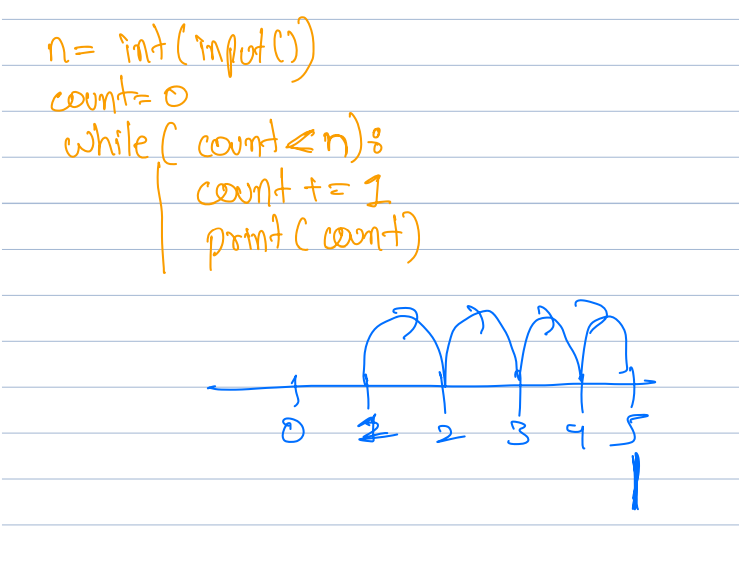
Print even numbers from 1 to 100¶
Example 3 - Print Even Numbers From 1 to 100¶
- Once done paste it into the chat section Note: Don't forget the updation of a variable. Also, some of the solutions have conditions where the loop doesn't run at all.
n = int(input())
count = 1
while count <= n:
if count % 2 == 0:
print(count)
count += 1
- Write the updation statement in the beginning only.
Alternative Solution:
In each interaction, we can update the count by 2. Initially, instead of starting from 1, we can start from 2, and in each iteration, we can do count += 2 this will always result in an even number.
n = int(input()):
count = 2
while count <= n:
print(count)
count += 2
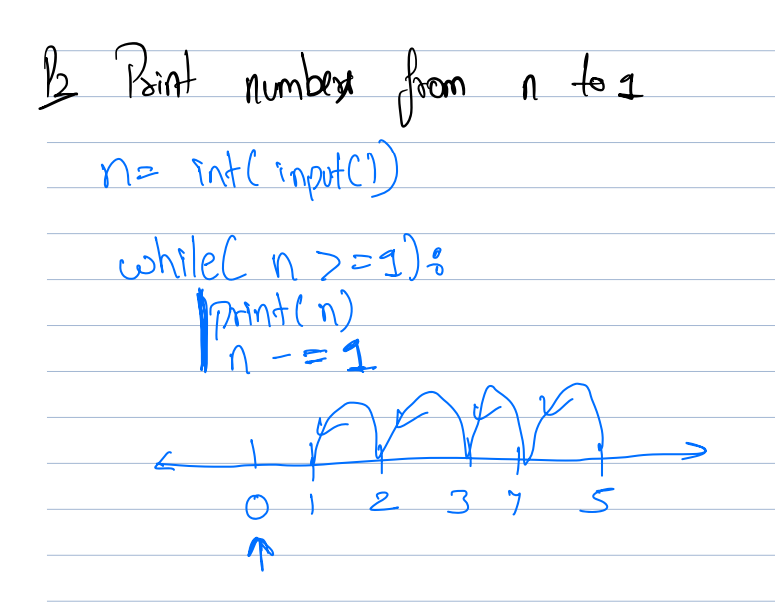
This is an optimization of the above code as we are not checking the condition as well as the loop will only run half the times of n.
Print the sum of all even numbers from 1 to 20¶
Example 4 - Print the Sum of All Even Numbers From 1 to 20¶
We already know how to generate even numbers between 1 to 20.
Instead of printing it, we need to store it in the bucket.
So we can keep adding these to a number and return the sum at the end.
sum = 0
count = 2
while(count <= n):
sum += count
count += 2
print(sum)
Print the digits of number 459¶
Example (VVIMP) - Print the Digits of Number 459 (order Doesn't Matter)¶
- How to get digits of a number in iteration
- Scraper -> extracts the last digit
- Scissors -> Cuts the last digit
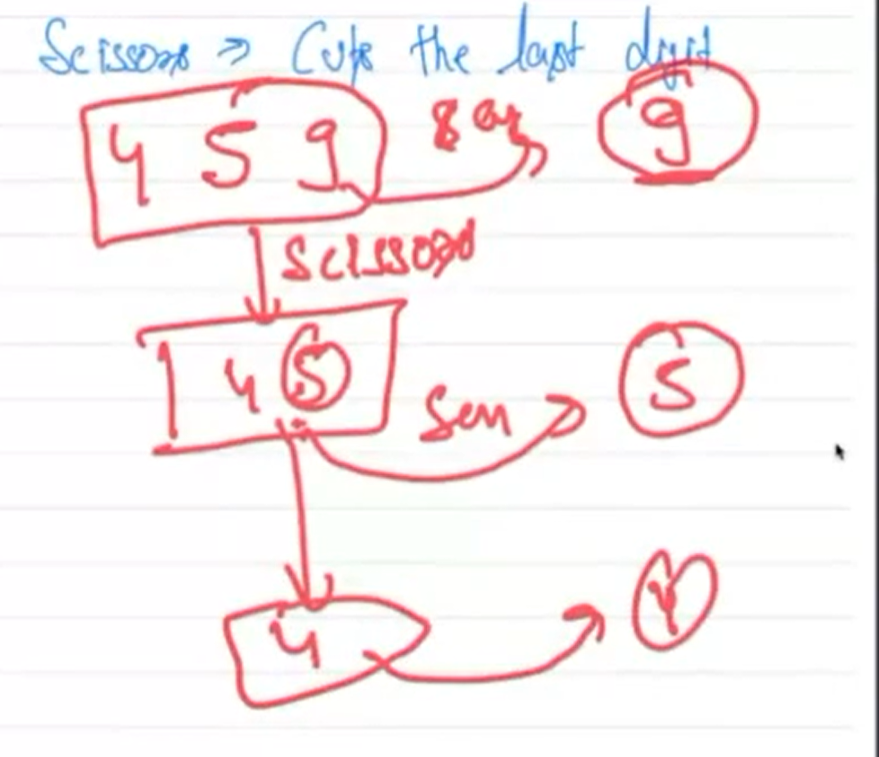
We will scrape the last digit, print the result, and cut the last digit. This process is continued until all the digits are cut. This is a loop, right?
Is there any operation I told you in the past which takes 459 and returns 9?
- taking
% 10(modulo 10) will return the last digit. 459 % 10 -> 945 % 10 -> 54 % 10 -> 4
Is there any operation that takes 459 and returns 45, basically cutting the last digit?
- taking
/ 10(integer division by 10) will return the last digit. int(459 / 10) -> 45int(45 / 10) -> 4int(4 / 10) -> 0
Only division will give the floor value such as 45.9. Also, 459 // 10 doesn't work with negative integers as -459 will give -45.9 -> -46. Thus, we can simply use int(val) to get the integer part of the remaining number.
n = int(input())
while n > 0:
print(n % 10)
n = int(n / 10)
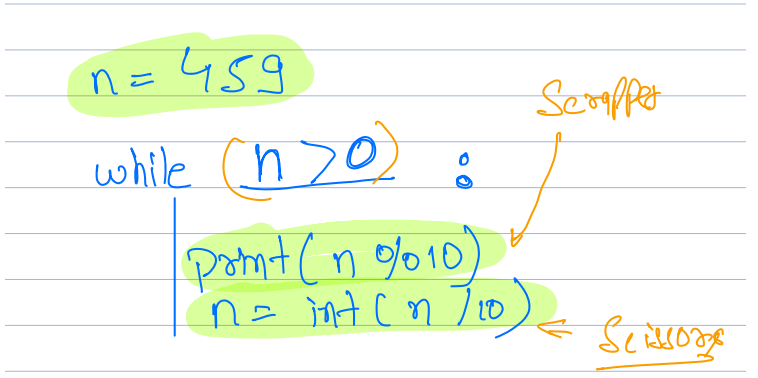
Question¶
What is the output of the following?
print(149 % 10)
Choices
- 14
- 9
- 1
- 0
Break and Continue Statements¶
Break Statement¶
Note: Only for loops
If you want to break out of the loop if a certain condition is met then you use break. It will break the entire loop and execute the next statement.
Definition Whenever a break is executed inside a loop, it terminates the loop.
What will be the output of the following code?
count = 1
while count <= 100:
if count == 4:
break
print(count, end=" ")
count += 1
Output
1 2 3
Continue Statement¶
Note: Only for loops
Definition It skips the inside loop and continues the loop's execution.
count = 1
while count <= 10:
count += 1
if count == 4:
continue
print(count, end=" ")
Output
1 2 3 5 6 7 8 9 10 11
- The continue statement simply skips the rest of the instructions of the current interaction and begins with the next iteration.
Look at the example below:
count = 1
while count <= 10:
if count == 4:
continue
print(count, end=" ")
count += 1
- This will end up in an infinite loop. As the updation condition is never performed due to continue statment. So once it reaches 4, it keeps looping on 4.
While-else¶
- Only and only in Python
-
Else block will run only after the loop successfully terminates without a break.
count = 1 while count <= 100: if count == 4: break print(count, end=" ") count += 1 else: print("Yayy!") -
It will not print
Yayy!as it is terminated via abreakstatement rather than terminating naturally.
Check whether a number is prime or not¶
Example - Check Whether a Number is Prime or Not¶
- Prime number is only divisible by
1or the number itself. - One is neither prime not consonant.
- We can say that
ais divisible bynifa % n == 0. - We can say that
24is not prime as24divides2, 4, 6, 8, etc. - We can say that
23is a prime number cause it only divides1and23. - Write a code to check if the number is prime or not. Start a loop from
2ton-1if it is dividing any number then returnnot primeelseprime. We are not required to usebreak,continue, orwhile else.
Solution 1:
Let us say our number is 25.
We will use a variable flag to store whether a number is prime or not. It is simply a boolean variable initialized with false.
As soon as the number is divisible by some other number we can change its value to true and it is not prime. If the number is not divisible by any other number the flag remains false and we can conclude that it is a prime number.
n = int(input())
count = 2
flag = False
while count < n:
if n % count == 0:
flag = True
count += 1
if flag:
print("Not Prime")
else:
print("Prime")
Solution 2:
- Is not very different from the previous solution.
- Now consider if the number is
9, it is divisible by3. Do we need to check for other numbers? We don't! If the given number is divisible by any other number, we can break from the loop and declare that it is prime. - This is a great situation where we can use
break.
n = int(input())
count = 2
flag = False
while count < n:
if n % count == 0:
flag = True
break
count += 1
if flag:
print("Not Prime")
else:
print("Prime")
Solution 2:
- We can remove the flag. We can use the
while elsestatement. - Instead of checking the flag, we can say that if we didn't break from the loop, it is a prime number.
- So as soon as we encounter that the number is divisible by some other number we print it is not prime. In the else part we print it is prime.
n = int(input())
i = 2
while i < n:
if n % i == 0:
print("not prime")
break
i += 1
else:
print("prime number")
Question¶
When can we say a number A is divisible by n?
Choices
- A % n == 0
- A / n == 0
- A // n == 0
- A % n != 0
Question¶
What is the output of the following?
count = 1
while(count <= 5):
if(count == 2):
break
print(count, end = ' ')
count += 1
Choices
- 1 3 4 5
- 1
- 1 2
- 0 1
Question¶
What is the output of the following?
count = 1
while(count <= 5):
if(count == 3):
continue
print(count, end = ' ')
count += 1
Choices
- 1 2 3 4 5
- 1 2 4
- 0 1 2 4 5
- Infinite Loop
